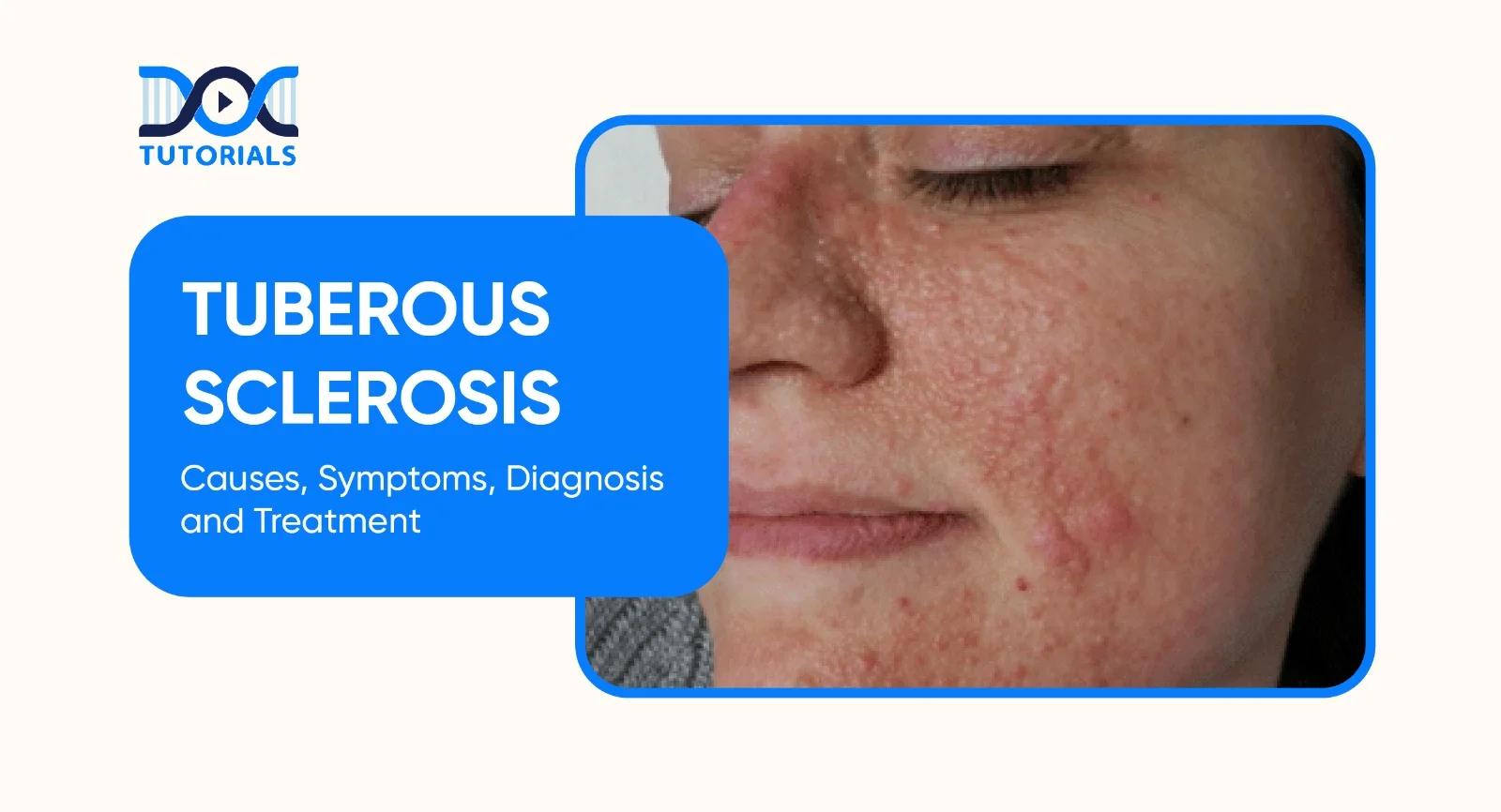Tuberous Sclerosis: Causes, Symptoms, Diagnosis, and Treatment

Tuberous sclerosis is a rare genetic condition that causes tumours to develop in many parts of the body. These tumours are not cancerous but can multiply with no limits. Tuberous sclerosis is often found during infancy or childhood. Approximately 1 in 6,000 to 1 in 10,000 live births are affected by tuberous sclerosis worldwide.
The brain, skin, kidneys, heart, lungs, and eyes are among the organs where it grows. These tumours, also known as hamartomas, can lead to a range of symptoms and complications, which makes tuberous sclerosis a variable and complex health condition.
If you are appearing for NEET PG, it is crucial to have a comprehensive understanding of the causes, symptoms, diagnosis, and treatment of tuberous sclerosis.
This not only helps you in achieving quality exam preparation but also provides a strong platform for making appropriate diagnoses and clinical judgements in real-life practice afterwards.
Keep reading to gain a complete understanding of this genetic disorder!
What is Tuberous Sclerosis?
Tuberous sclerosis is a rare genetic disorder which results in noncancerous tumours that spread throughout the body. Currently, there is no cure for tuberous sclerosis, but with proper management, many symptoms can be controlled.
Individuals with this disorder may experience a range of symptoms. People with less severe cases may lead normal lives with minimal adverse effects. However, severe cases can lead to serious complications. Individuals with this condition will need to consult a doctor regularly throughout their lives to monitor its progression.
What Causes Tuberous Sclerosis?
Since tuberous sclerosis is a genetic condition, it develops due to mutations in specific genes, usually TSC1 or TSC2. These genes are responsible for producing tumour-suppressing proteins that help control how cells grow and divide.
The body’s cells usually divide simply to replace old or damaged cells. Tumour-suppressing proteins maintain the balance and health of this process by controlling the size of the cells as well as their rate of division.
When the balance is disturbed due to the proteins being less or malfunctioning as a result of genetic mutations, cells may begin to grow larger than usual and more rapidly. Over time, this leads to the formation of extra, abnormal cells that form together as noncancerous tumours.
These tumours can appear in various organs, including the brain, skin, kidneys, heart, and lungs, which leads to the wide range of symptoms seen in tuberous sclerosis.
What are Tuberous Sclerosis Symptoms?
Tuberous sclerosis symptoms are caused by noncancerous growths in different parts of the body, most commonly in the skin, brain, eyes, kidneys, heart and lungs. Symptoms can range from mild to severe, depending on the size or location of the growths.
Although symptoms are different for each person with tuberous sclerosis, they can include:
Skin Symptoms:
- White spots on the skin (caused by a loss of pigment) that resemble confetti or ash leaves
- Facial angiofibromas, red areas on the face with numerous blood vessels.
- Elevated areas of skin, frequently on the back, that have an orange-peel texture
Brain Symptoms:
- Autism spectrum disorders
- Intellectual disability
- Seizures
Other Symptoms:
- Enamel pitted in the teeth
- Rough growths beneath or surrounding the toenails and fingernails
- Tumours on or near the tongue that are rubbery and non-cancerous
If a patient sees any signs of tuberous sclerosis symptoms or has concerns about the child’s development, get in touch with the health care provider immediately.
What are the Risk Factors of Tuberous Sclerosis?
There are two possible risk factors of tuberous sclerosis:
- A Random Cell Division Error
A newly discovered mutation in either the TSC1 or TSC2 gene associated with tuberous sclerosis is present in approximately two-thirds of patients with the disease. Most people do not have a family history of tuberous sclerosis.
- A Gene Change Passed Down in Families
About one-third of people who have tuberous sclerosis get a mutated TSC1 or TSC2 gene from a parent who has the disorder.
If you have tuberous sclerosis, you have up to a 50% chance of passing the altered gene and the disorder to your biological child, which means that children related to you by blood may inherit that gene.
How is Tuberous Sclerosis Diagnosed?
Healthcare professionals can classify the symptoms and warning signs of tuberous sclerosis into two categories – major and minor features, which are as follows:
Major Features
- At least three ash leaf spots, each with a maximum width of 5 millimetres (mm).
- A fibroma plaque or two or more facial fibromas on your head or face.
- At least one fibroma on a fingernail or toenail.
- One Shagreen patch.
- Specific kinds of brain tissue growth.
- Benign tumours that can affect your kidneys, lymph nodes, or lungs.
Minor Features
- Skin lesion from confetti.
- Your teeth’s enamel has four or more pits.
- Your mouth has two or more growths.
- Growths on the retina
- Your kidneys have multiple cysts.
There are many types of tests that are performed to diagnose tuberous sclerosis in the brain, skin, or any other part of the body.
Some of them are as follows:
- Computed Tomography (CT) scan
- Magnetic Resonance Imaging (MRI)
- Electroencephalogram
- Skin Biopsy
- Genetic Testing
What is the Treatment for Tuberous Sclerosis?
Although there is no cure for tuberous sclerosis, it is often treatable. Usually, the types of symptoms determine the treatment methods. Some of the main types of treatment are:
- Medications: Many of the symptoms of tuberous sclerosis can be decreased by medications. Seizures and other brain-related symptoms can be treated with certain medicines.
- Surgery: Surgery may be required in certain situations to remove growths from inside the patient’s body.
- Dermatology Treatments: These procedures remove the visible portions of any growths on or near your skin. Some of the dermatology treatments are cryoablation, laser skin resurfacing, dermabrasion or dermaplaning, excision and skin grafts.
These treatments can significantly improve both the physical appearance and emotional well-being of individuals living with tuberous sclerosis.
FAQs About Tuberous Sclerosis
- Who is most at risk for tuberous sclerosis?
There are no known risk factors other than having a parent with tuberous sclerosis. In that case, each child has a 50% chance of inheriting the disease.
- Can tuberous sclerosis be prevented?
Tuberous sclerosis is a genetic condition that can’t be prevented. It happens when parents pass a mutated gene to their child or when a gene mutation occurs spontaneously. Genetic counselling and testing may be recommended by your doctor if you have a parent or sibling with tuberous sclerosis.
- How is tuberous sclerosis diagnosed?
Diagnosis is typically made through genetic testing and imaging studies like MRI or CT scans. For additional information, doctors may also conduct renal ultrasounds, eye exams, and skin examinations.
- Can people with tuberous sclerosis live a normal life?
Many individuals with tuberous sclerosis lead normal lives, especially with early diagnosis and appropriate care.
- What are the main symptoms of tuberous sclerosis?
Symptoms vary widely but may include seizures, developmental delays, skin abnormalities, kidney tumours, lung problems, and behavioural or psychiatric issues.
Conclusion
Tuberous sclerosis is a rare but serious genetic disorder that can affect multiple organs in the body. While it has no cure, early diagnosis and appropriate treatment can help manage symptoms and improve quality of life.
For medical students and professionals, especially those preparing for NEET PG, a solid understanding of this condition is essential for accurate diagnosis and effective patient care.
DocTutorials provides expertly crafted video lectures, high-yield revision programmes, and detailed notes tailored to help you excel in your exam and future practice.
Enrol in DocTutorials’ NEET PG course today and enhance your preparation for a successful medical career!
Latest Blogs
-

NEET SS Exam 2024: Analysis, Key Dates, Counselling
The NEET SS 2024 exam kicked off on March 29, 2025. Over two days and two slots, candidates across 13…
-

NEET PG Registration 2025: An Essential Guide For Exam Prep
The NEET PG registration, which is conducted online, is a crucial step in the exam process. Filling out the NEET…
-

NEET PG Syllabus 2026: A Must-Have Complete Guide for Exam Success
The NEET PG Syllabus acts as one of the foundation stones for aspiring postgraduate medical students like you who are…




